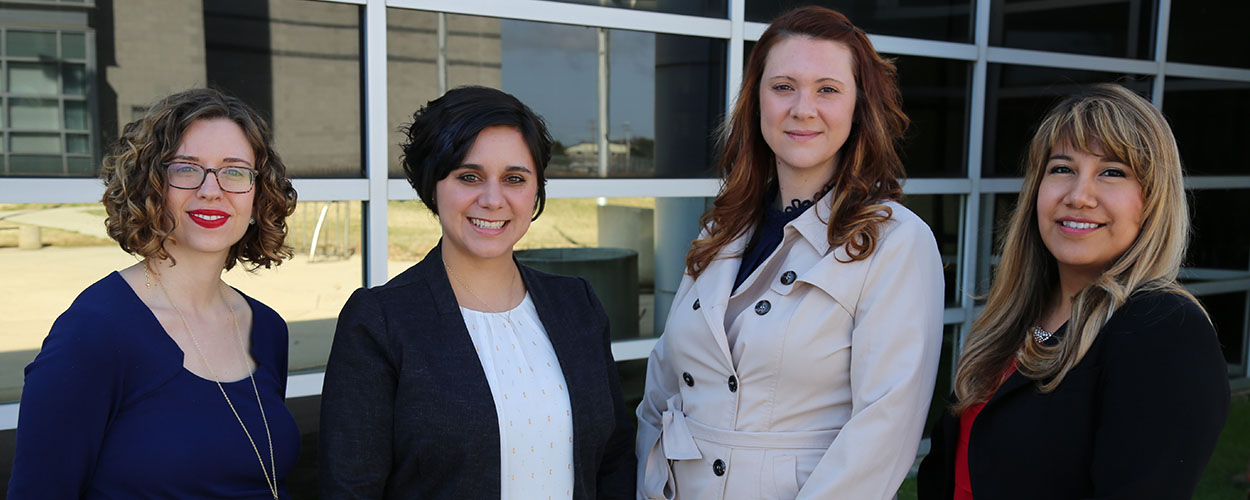Women Researchers Provide Soldier Support Through Science
Women Researchers Provide Soldier Support Through Science
By Gay Pinder
From Marie Curie to Mae Jemison, women researchers have contributed significantly to scientific understanding. From the discovery of radium to studying the applications of space flight, women have carved out a place for themselves in a male-dominated field.
Women scientists at the U.S. Army Combat Capabilities Development Command (CCDC) Chemical Biological Center are at the forefront of developing innovative ways
to protect the warfighter.
Erin Durke, Ph.D., Elizabeth Dhummakupt, Ph.D., Megan Hower and Jennifer Soliz, Ph.D., are leading the way in protecting Soldiers from the effects of chemical and biological agents.
Now, much of Durke’s time is dedicated to studying aerosols and materials in those chambers.
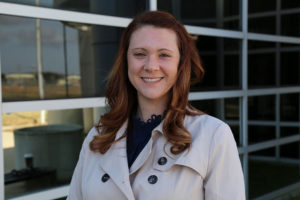
Durke, a research chemist with a Ph.D. from Virginia Tech, began her career at the Center in 2011 as a post-doctoral researcher studying the interactions of chemical warfare agents (CWAs) and surfaces using an ultra-high vacuum (UHV) chamber – the first time such an experiment had been undertaken. The Center currently has four chambers and remains the only facility in the world to test chemical agent in UHV chambers.
“We try to understand CWA reactions at the most fundamental level,” Durke said. “By utilizing UHV chambers, which operate at pressures in the 10-9 – 10-10 Torr (atmosphere is 760 Torr), the only molecules present in the chamber are those we intend to study. So we install a surface of interest, perhaps a new material for filtration or protection, and expose it to CWA and follow the reaction in real-time with multiple techniques.”
Durke explains that studying the effects of CWAs on various materials aids in the development of new protective clothing, filtration media, and substances that can enhance warfighter safety.
Just a few doors away, Jennifer Soliz works to support the warfighter in a different way. With a background in inorganic chemistry, Soliz focuses on her latest discovery, self-indicating colorimetric response materials, which she holds patents on.
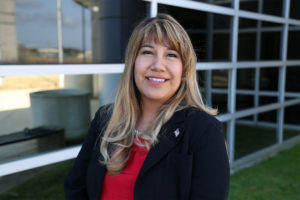
Soliz, who earned her Ph.D. from The Ohio State University, synthesizes inorganic compounds that detect hazardous chemical threats by changing color in their presence.
“For example, I’ve developed a blue compound that turns yellow in the presence of mustard gas,” Soliz said. “I have also synthesized other colored compounds that change color in the presence of Sarin and VX.”
Soliz works with various transition metals containing d-electrons. According to Soliz, these materials provide exciting opportunities regarding how they change optically, electronically and magnetically in the presence of hazardous threats. These materials have the potential to provide innovative ways to approach the detection of chemical agents.
One such innovation is the ability of Soliz’s compounds to detect the existence of agent vapors that emit from porous surfaces – something typical organic M8 paper or portable Infrared detectors cannot do.
“You may have a porous surface like concrete. The concrete can absorb chemical agent and become an unseen threat,” Soliz explained.
In a practical application, a drone coated with an array of Soliz’s colorimetric compounds could navigate through a contaminated battlefield and return with a different color, indicating the presence of toxic vapors from specific chemical threats.
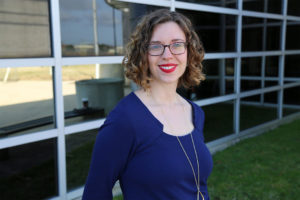
Elizabeth Dhummakupt, who studied at University of Florida for her Ph.D., also researches chemical agents, but from a different angle. Although trained in mass spectrometry, her current research involves biomarker discovery. Biomarkers are molecular substances in the body that can be used to indicate health or disease. Dhummakupt looks at human and animal biological samples to determine if the subject has been exposed to a particular chemical agent and how the body responds to that exposure.
“We’re looking for certain signatures that can tell us what’s going on even though the person exposed might not feel any different,” Dhummakupt explained.
In addition to her chemical agent biomarker study, Dhummakupt also conducts biomarker research in human performance which could impact higher level command strategy. With access to quantitative data revealed by biomarkers, Dhummakupt says a Soldier’s commander can make a better informed decision as to whether a Soldier can perform as he or she is required to accomplish the mission.
All three women are principal investigators in the Research and Technology Directorate of the Center where they oversee and manage projects, including budget, milestones, deliverables and of course, the actual research.
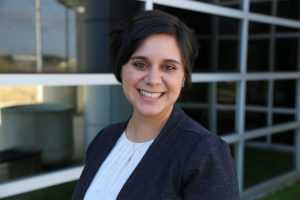
Megan Hower, who works in the Center’s Engineering Directorate, puts her biochemistry degree to use in a way she could not have imagined while attending Bucknell University. As chief of the Acquisition Program Management & Matrix Support Division, Hower oversees the matrix workforce, a group of acquisition experts in technical fields embedded within acquisition program executive offices, including the Joint Program Executive Office for Chemical, Biological, Radiological and Nuclear Defense (JPEO-CBRND).
“The matrix workforce bridges the acquisition program of record focus of the JPEOs and the technical base and underlying chemical and biological expertise of the Center,” she said. Her biochemistry studies prepared her for Center projects that involve detecting harmful chemical, biological, radiological, and nuclear substances, and using protective technologies to shield the warfighter from agent threats.
Hower spent most of her career as one of those matrix professionals, working with teams to develop and sustain a number of specialized respiratory masks for the warfighter as well as radiological and nuclear detection systems. She then progressed to product manager and to chief systems engineer for radiological and nuclear defense.
“It was very technical,” Hower reflected. “Now I look at how we can better manage and connect with the matrix workforce. How do we all work together to achieve end goals … improving acquisition, innovating technologies and supporting programs of record to get products to the warfighter?”
Taking a warfighter solution from the drawing board to the battlefield is Hower’s purview as an acquisition chief.
“Acquisition is huge and complex,” Hower said. At the Center, acquisition specialists are involved in all stages of developing products for the warfighter, including defining the Soldiers’ needs and developing items that have never been made, modifying and procuring existing products, fielding products, understanding their sustainment and planning for their disposal.
The Center’s matrix workforce executes all of this while adhering to a plethora of federal laws and regulations.
Hower began her career in sustainment near the end of the product lifecycle, and worked her way backwards in the process.
“I advocate for that approach because what it meant was that I had a perspective,” Hower said. “Each time I went to my next program, I could see the downline effect of the decisions we would make which I don’t think I would have had if I had gone about it a different way.”
Overcoming Challenges
Deciding to pursue careers in science provides rewards for each woman. They enjoy working collaboratively with coworkers on innovative projects, but admit to facing challenges at times in their careers.
“Several years ago, I attended a program managers’ review. I sat at the table and realized I was the only female, the only person not in uniform and the youngest person by 15 years,” Hower said.
Coming from a long line of independent women, Hower said that she didn’t let the experience intimidate her; instead she asked herself, “How can I contribute?”
For Soliz, the challenge is sometimes overcoming a three-fold sense of professional isolation: being a woman, a Latina and a Native American in science.
“I stick out,” Soliz said. The University of Texas at Austin, Soliz’s undergraduate alma mater, recently invited her to speak at a gathering of young women interested in pursuing careers in science. “I was happy to see that there were several highly motivated women of all colors at the gathering. I think it’s important to meet and interact with women in strong leading roles,” Soliz added.
When deciding to pursue her Ph.D. in 2010, Dhummakupt recalls encountering one of the oldest stereotypes about women.
“I did encounter some men who thought that women should not become Ph.D. scientists because all they were going to do was get married and have kids and leave the field,” she said.
Balancing Act
Dhummakupt, a mother of an almost 3-year-old with another expected in June, admits striking the optimal work-life balance can be difficult.
“I love my job, that’s one reason why I work as a parent,” she said. “I love what I do and the impact it has, but sometimes colleagues, emails and phone calls have to wait; I have to focus on my family.”
Soliz and Durke agree. Both are mothers and say trying to do it all can be a struggle, but it’s also rewarding.
“I love my daughter. She is the absolute world to me,” Soliz said. “But I also love working. I want my daughter to be inspired and say, ‘I can do this.’ I want her to succeed and be all she can be.”
“The mom part is the hardest,” said Durke, a mother of three girls and a boy. She said that balancing her responsibilities as a principal investigator with her parental responsibilities, “is still really hard.”
No matter how hard the work-life balance may be, these scientists know it’s even harder for the warfighter.
Soliz’s father served in the Marines during the Vietnam War and her grandfather served in the Army during WW II. She says that her work motivates her on a personal level as well as professionally.
“I think back to the stories of my father and my grandpa serving in the military, and they are my inspiration to serve my country,” Soliz said. “If my work can provide a benefit to the Soldier, then I feel like I’ve done my job.”
“Those men and women are out there every day risking their lives for us,” Durke said. “If there is something we can do on our side to help make sure they come home, what better motivation do you need?”
“That’s one of the main reasons I love coming to work here,” Dhummakupt said. “I know what I’m doing is protecting people… protecting people who are protecting me, my family and my country.”
“This is the heart of what we do,” Hower said.
Advice to Future Scientists
Dhummakupt, Durke, Hower and Soliz are subject matter experts in their fields who have earned the respect of colleagues at the Center and beyond. For any women who strive to be leaders in science, they have some words of advice.
“Don’t let yourself get boxed in.” Dhummakupt suggests that a chemist might consider learning to code. “Everything is very fluid now. Discover what skills you need beyond your regimented coursework,” she said.
Durke suggests taking advantage of the changing culture.
“There is so much effort now to ensure there is equality, that there are as many women as there are men in positions in science,” she said. “There are internships and scholarships, and some are just for women like the Clare Boothe Luce Scholarship. I was lucky enough to win that scholarship.”
For Soliz, it comes down to this. “If you absolutely love what you do, don’t let anything stop you.”
Leading women researchers at the U.S. Army Combat Capabilities Development Command Chemical Biological Center. Left to right: Elizabeth Dhummakupt, Megan Hower, Erin Durke & Jennifer Soliz.
Photo by Jack Bunja.

